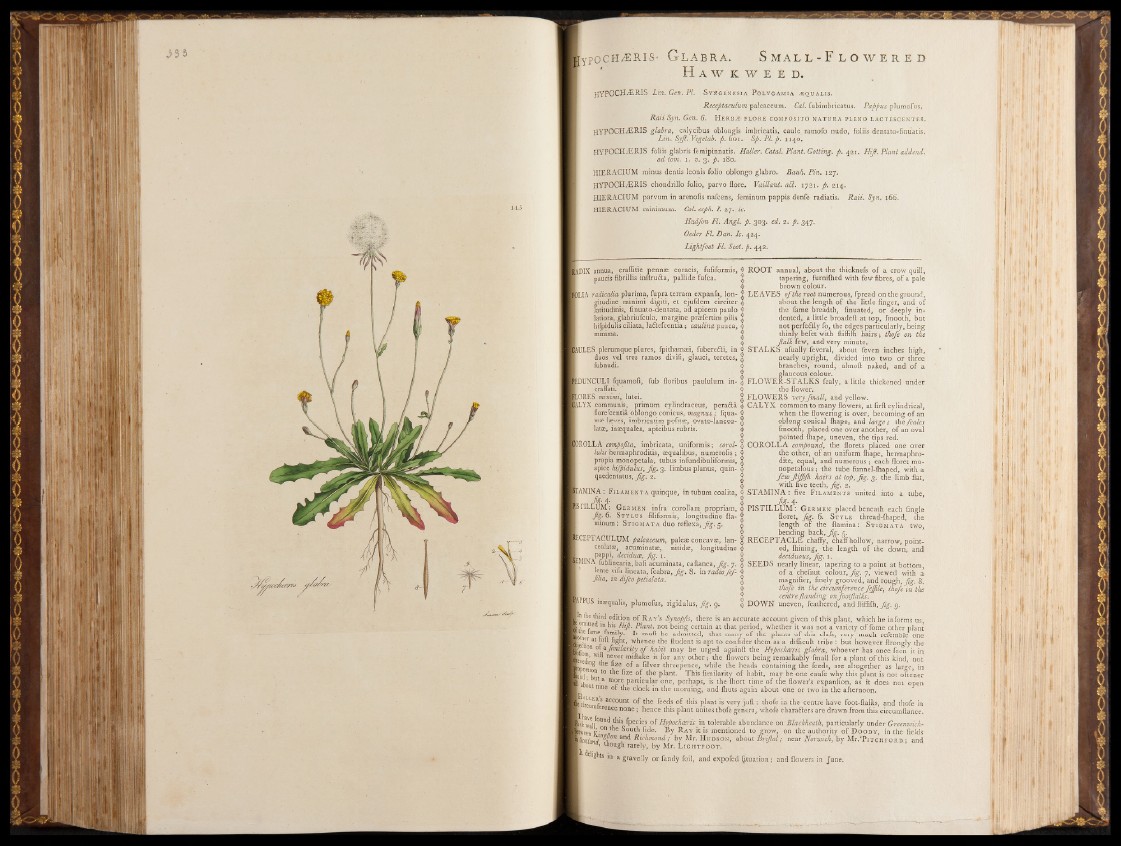
H a w k w e é d .
HYPOCHÆRIS Lin. Gen. PL S yn ge 'n e s ia P o l y g am ia æ q u a l is .
Receptaculum paleaceum. Cal. fubimbricatus. Pappus plumofus,
Raii Syn. Gen. 6. H er bæ f lo r e c om po s ito n a t u r a plen o l a c t e s c e n t e s .
HYPOCHÆRIS glabra, calycibus oblongis imbricatis, caule, ramofo nudo, foliis dentato-finuatis,
Lin. Syß. Vegetab. p. 601. Sp.Pl.p. 1140.
HYPOCHÆRIS foliis glabris femipinnatis. Haller. Catal. Plant. Gotting, p. 421, Hiß. Plant addend,
ad tom. 1. V. 3. p. 180.
HIERACIUM minus dentis leonis folio oblongo glabro. Bauh. Pin. 127.
HYPOCHÆRIS chondrillo folio, parvo flore. Vaillant. aCt. 1721. p. 214.
HIERACIUM parvum in arenofis nafcens, feminum pappis denfe radiatis. Raii. Syn. 166.
HIERACIUM minimum. Col. ecph. I. 27. ic.
Hudfon FL Angl. p. 303. ed. 2. p. 347,
Oeder Fl. Dan. Ic. 424.
Lightfoot Fl. Scot. p. 442.
■ ADIX annua, craffitie pennae coracis, fufiformis, $ ROOT annual, about the thicknefs of a crow quill,
* paucis fibrillis inftru&a, pallide fufca. % tapering, furnilhed with few fibres, of a pale
$ brown colour.
SoUA radicalia plurima, fupra terram expanfa, Ion- | LEAVES of the root numerous, fpread on the ground,
X gitudine minimi digiti, et ejufdem circiter % about the length of the little finger, and of
latitudinis, finuato-aentata, ad apicem paulo $ the fame breadth, finuated, or deeply in»
latiora, glabriufcula, margine praefertim pilis | dented, a little broadeft at top, fmooth, but
hifpidulis ciliata, laftefcentia; caulina pauca, \ not perfe&ly fo, the edges particularly, being
minima. | thinly befet with ftiffilh hairs; thofe on the
$ Jlalk few, and very minute.
RULES plerumque plures, fpithamaei, fuberefti, in $ STALKS ufually feveral, about feven inches high,
duos vel tres ramos divifi, glauci, teretes, & nearly upright, divided into two or three
fubnudi. $ branches, round, almoft naked, and of a
| glaucous colour.
RDUNCULI fquamofi, fub floribus paululum in- | FLOWER-STALKS fcaly, a little thickened under
craffati. ' $ • the flower.
[LORES minimi, lutei. | FLOWERS veryfmall, and yellow.
llLYX communis, primum cylindraceus, pera&a $ CALYX common to many flowers, at firft cylindrical,
florefcentia oblongo conicus, magnus,; fqua- 0 when the flowering is over, becoming of an
mas lasves, imbricatim pofitae, ovato-lanceo- | oblong conical Ihape, and large ; the fcales
latas, inaequales, apicibus rubris. $ fmooth, placed one over another, of an oval
J t pointed fhape, uneven, the tips red.
BROLLA compofta, imbricata, uniformis; corol- ij COROLLA compound, the florets placed one over
lulis hermaphroditis, sequalibus, numerofis ; $ the other, of an uniform Ihape, hermaphropropia
monopetala, tubus infundibuliformis, X dite, equal, and numerous ; each floret mo»
apice hifpidulus, fig. 3. limbus planus, quin- $ nopetalous; the tube funnel-Ihaped, with a
quedentatus, fig. 2. | few fiijfifh hairs at top, Jig. 3. the limb flat,
$ with nve teeth, Jig. 2,
ffAMINA : Filamenta quinque, in tubum coalita, $ STAMINA: five Filaments united into a tube,
I fig- 4* | Jig. 4.
|SriLLUM: Germen infra corollam propriam, $ PISTILLUM: Germen placed beneath each fingle
fig. 6. Stylus filiformis, longitudine fta- | floret, fig. 6. Style thread-fhaped, the
minum: Stigmata duo reflexa, fig. 5. $ length o f the ftamina: Stigmata two,
t . bending back, fig. 5.
yiCEPTACULUM paleaceum, paleas concavas, lan- | RECEPTACLE chaffy, chaff hollow, narrow, point-
ceolatas, acuminatae, nitidas, longitudine p ed, Ihining, the length of the down, and
fM PaPPG decidua, fig. 1. | . deciduous, Jig. 1. .
S-MINA fublinearia, bafi acuminata, caftanea, fig. 7. | SEEDS nearly linear, tapering to a point at bottom,
lente vifa lineata, fcabra, fig. 8. in radiofif- & of a chefnut colour, 7, viewed with a
Jilia, in difco petiolata. magnifier, finely grooved, and rough, fig. 8.
h thofe in the circumference feffile, thofe in the
■a potto • . | centre Jlanding Onfootfialks.
I ln®qualis, plumofus, rigidulus* fig. g. § DOWN uneven, feathered, and fliffilh, fig. g.
[in the third edition of Ra y ’s Synopfis, there is an accurate account given of this plant, which he informs us,
■ omitted in his Hift. Plant, not being certain at that period, whether it was not a variety of fome other plant
■ toe lame family. It muft .be admitted, that many of the plants of this clafs, very much refemble one
at *!r“ fighL whence the lludent is apt to confider them as a difficult tribe : but however ftrongly the
i(r10n °}ffimilarity of habit may be urged againft the HypochayiS glabra, whoever has once feen it in
lee?’ Wl! n®ver miftake it for any other; the flowers being remarkably final! for a plant of this kind, not
1 p i t*le “ ze ° f a filver threepence, while the heads containing the feeds, are altogether as large, in
Vnd^ T 1 t0 111 ° f plant. This fimilarity of habit, may be one caufe why this plant is not oftener
it aboutUt'4 mpre Part*cul^r oneJ perhaps, is the fliort time of tbe flower’s expanfiop, as it does not open
1 nine of the clock in the morning, and Ihuts again about one or two in the afternoon..
»ircumfS aCC0Unt l | i ^ee(^.s ffe: plant is very ju ft: thofe in the centre have foot-ftalks, and thofe in
If erence none; hence this plant unites thofe genera, whofe charaflers are drawn fro.m this circumftance.
l^walf0Un<^ * P ec*es Hypochoeris fix tolerable abundance on Blackheath, particularly under Greenwich-
IweenK'011^ 6 Ry Ray it is mentioned to grow, on the authority of P oody, in the fields
i a”d Richmond; by Mr. Hudson, about Brifiol; near Norwich, by Mr.'PiTCHFORD: and
^ “««d, though'r a r e ly , by Mr. L ig h t f o o t . .
lights in 1 gravelly or fandÿ foil, and expofed (jtuation; and flowers in June.